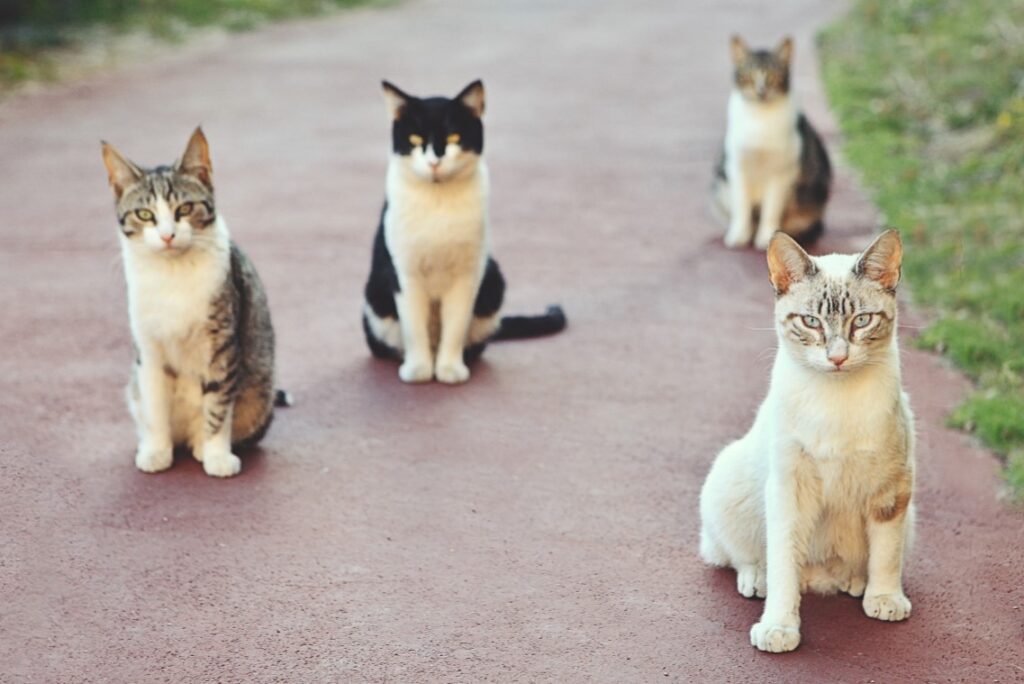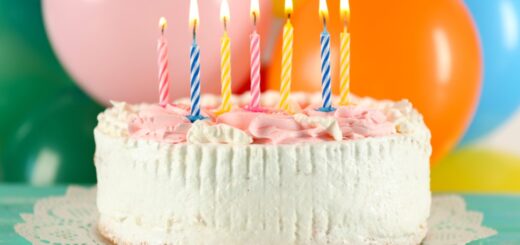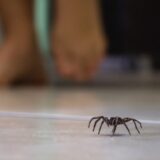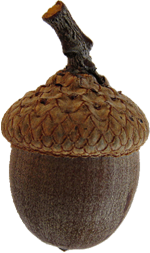View Superstitions About
Beyond the enigma of black cats, superstitions surrounding cats in general are equally diverse and intriguing. Let’s unravel the tales and beliefs that make cats central figures in folklore.
Nine Lives and Beyond
Mythical Resilience
The notion that cats have nine lives is a widespread belief. If a cat follows you, it’s considered a sign of future wealth. However, a bought cat is thought to be ineffective at catching mice.
Aura Sensing
Some believe cats can see the human aura, the energy field that surrounds each person. Sacred cats in ancient Egypt were even interpreted by priests to predict future events based on their movements – twitch of a whisker, yawn, or stretch.
Predictors of the Weather and the Elements
Cats, with their mysterious behaviors and keen instincts, have been regarded as nature’s weather forecasters in many cultures. Let’s dive into the fascinating world of feline meteorology.
Wind Whispers Through Claws
Cats seem to have an uncanny ability to predict the wind. Owners have observed their feline friends clawing at carpets and curtains just before a gusty breeze sweeps through. This peculiar behavior suggests a feline sensitivity to changes in air currents.
Ear-Washing Rainfall Indicator
A busy cat meticulously washing its ears is believed to be a strong indicator of impending rain. The diligent ear-cleaning ritual seems to coincide with atmospheric shifts that precede rain showers, adding another layer to the mystique of feline weather prediction.
Feline Barometer in Action
Keeping a cat confined indoors during certain weather conditions was thought to influence the weather itself. Ancient beliefs held that locking up a cat could bring an end to bad weather, as if the cat held a mystical connection to atmospheric forces.
Witches and Storm-Riding Felines
In folklore, witches were said to ride on storms, often taking the form of cats. This association between cats and storms further emphasizes the supernatural aura surrounding these enigmatic creatures. Their link to weather-related phenomena paints them as both witnesses and conduits of nature’s powerful forces.
Symbolism and Cultural Clues
Cats and Dogs: A Weather Phrase Origin
The phrase “it’s raining cats and dogs” may find its roots in the symbolic roles attributed to cats and dogs in weather lore. Cats came to symbolize downpouring rain, while dogs were associated with strong gusts of wind. This cultural metaphor likely shaped the expression we use today.
Backs to the Fire: Harbingers of Cold
Observant early American cat owners noted that when their feline companions sat with their backs to the fire, a cold snap was on the horizon. This behavior served as a quirky yet effective early warning system for impending chilly weather.
Omens of Rain and Bad Weather
Rain Predictors: A Feline Symphony
Several cat behaviors were considered omens of rain:
- A cat licking its tail.
- A cat licking itself clean.
- A cat washing behind its ears.
- A cat resting with the flat part of its head on the ground.
- A sneezing cat.
- Continuous gazing out of a window, especially on any day, hinted at impending rain.
Pupils and Precipitation: The Welsh Belief
According to Welsh superstition, when the pupil of a cat’s eye broadens, rain is on the way. This keen observation of feline ocular changes added a unique dimension to weather prediction in different cultures.
Signs of Stormy Weather: Feline Clues
Certain cat behaviors were considered indicators of bad weather:
- A restless cat.
- A cat putting its tail or with its back toward the fire.
- A cat scratching the leg of a table, signaling an imminent change in the weather.
Cats, with their peculiar habits and mysterious ways, have woven themselves into the fabric of weather folklore. Whether predicting rain, wind, or cold snaps, these feline meteorologists add a touch of whimsy to our understanding of the natural world.
Cats and the Sick, Dying, and Dead
Exploring Feline Powers in Sickness and Death
A Feline Oracle of Health
In English superstition, the presence or absence of cats held a special significance. It was believed that if cats deserted a house, illness would inevitably prevail within its walls. The mysterious connection between feline behavior and the well-being of inhabitants added an air of mysticism to these domestic guardians.
Cat Cures: Folk Wisdom and Curiosities
Ancient Japanese Wisdom
In ancient Japan, a fascinating belief prevailed regarding the healing powers of a cat’s tail. It was thought that somewhere on the tail of a cat, there existed a single hair with the magical ability to restore life to a dying person. This mystical strand became a symbol of hope and recovery in times of dire illness.
Early American Remedies: Black Cat Brews
Early American colonists harbored peculiar beliefs about the medicinal properties of black cats. A broth made from boiling a black cat was thought to possess the cure for tuberculosis. However, the fear of incurring bad luck deterred individuals from testing this unorthodox remedy, leaving it shrouded in superstitious caution.
Fur, Blood, and Healing
In the annals of folk medicine, various parts of a cat’s anatomy were believed to hold potent cures for diverse ailments. From fur to blood, these mysterious concoctions were considered remedies that could miraculously address a range of health issues, embodying the essence of ancient healing practices.
Warding off Ailments: The Cat’s Tail and Eye Styes
For those plagued by eye styes, a curious folk cure involved rubbing the affected area with the tail of a black cat. The mystical properties attributed to the cat’s tail were harnessed in the hope of alleviating discomfort and promoting healing.
Magical Ashes and Milk Mixtures
Ashes from the burnt head of a black cat were believed to hold curative powers for eye diseases when delicately blown into the eyes. Additionally, a concoction of cats’ blood mixed with milk was considered a potent treatment for shingles, reflecting the ancient belief in the mystical healing properties of feline elements.
Gravy of Healing: Stewed Black Cat for Consumption
A particularly unusual remedy involved preparing gravy made with stewed black cat to address consumption. This remedy, steeped in superstition, underscores the intriguing lengths people would go to harness the purported healing energies of these enigmatic creatures.
Tortoiseshell Wart Cure: A May Ritual
In the realm of wart treatment, the tail of a tortoiseshell cat was believed to possess unique powers, but only if applied during the month of May. This specific timing added a seasonal dimension to the folk practices surrounding cats and their perceived ability to cure various ailments.
Sties, Warts, and Toothaches: The Cat’s Touch
Rubbing the tail of a black cat on the eyelid was believed to cure sties, while cats’ blood was considered an effective remedy for warts. Swallowing nine hairs from the tail of a black cat was thought to alleviate whooping cough, and holding a dried catskin over the face was believed to provide relief from toothache.
Cats and Death: Ominous Signs and Superstitions
Feline Harbingers of Doom
In the realm of death-related superstitions, cats played a prominent and foreboding role:
- Fighting Cats and Sickness: The sight of two cats fighting was considered an ominous sign for the health of a sick person.
- Cat Abandonment in Sickness: If a cat left a house with a sick person and refused to return, it was seen as a portent of impending doom.
- Transylvanian Jumping Cat: In Transylvania, the unsettling belief held that if a cat jumped over a corpse, the deceased would transform into a vampire.
Perception of Death: Cats as Mystical Observers
Some believed that cats possessed the ability to perceive the specter of death. Whether through uncanny intuition or mystical senses, cats were considered mysterious observers of the impending transition between life and death.
16th Century Italian Omens
In 16th century Italy, the presence of a black cat lying on the bed of a sick individual was seen as an ill-fated omen, foretelling the person’s impending demise. Conversely, the refusal of a family cat to remain indoors when someone was about to die was considered a bad omen, creating an atmosphere of superstition and foreboding.
Scottish Blinding Belief
Scottish immigrants harbored a curious belief that if a cat entered a room where a dead body lay in state, the next person to touch the cat would be blinded. This peculiar superstition led to the immediate demise of the cat in such situations, highlighting the perceived supernatural consequences.
Funeral Processions and Tortoiseshell Signs
The presence of a tortoiseshell cat in Normandy was believed to foretell death by accident. A cat perched atop a tombstone was considered a sign that the soul of the departed was possessed by the devil. Furthermore, two cats seen fighting near a dying person or on a grave shortly after a funeral were believed to represent the eternal struggle between the Devil and an Angel for possession of the departed soul, according to old English superstitions.
In the tapestry of superstitions surrounding cats, the intersection of healing, death, and mystical omens weaves a rich narrative of human beliefs and fears, where felines stand as enigmatic figures with both curative and foreboding qualities.
Love, Luck, and More
Matchmakers and Wedding Guests
Cats were believed to play a role in love and marriage. Dreaming of a black and white cat was considered a sign of luck with children, and having a family cat at a wedding was deemed good luck.
Superstitions of Harm
Folklore warns against hurting cats, associating it with severe consequences such as rheumatism or sacrificing one’s soul to the Devil. A particular Irish superstition claims that killing a cat brings seventeen years of bad luck.
Dreaming About Cats
Dreaming of cats held diverse interpretations in various cultures. While a black cat in a dream was sometimes seen as a sign of impending bad luck, a white cat often symbolized good fortune.
Cats: Magical Beings in Folklore
In the realm of superstitions, cats emerge as mythical beings, woven into the fabric of human beliefs across cultures and centuries.
Witches and Familiars
Clever Companions
The association between cats and witches transcends time. Cats were believed to possess traits like cleverness, unpredictability, and healing. They were thought to be witches’ familiars or even the witches themselves in disguise.
Dark Allegations
In medieval times, cats, particularly black ones, were accused of supernatural affiliations. The belief that a black cat walking into a sick person’s room could cause their demise fueled fear and superstition.
Rituals and Demons
The notion that a black cat is a witch’s familiar extended to rituals for finding buried treasure in France and even to early American colonists, who believed that boiling a black cat could cure tuberculosis.
Cats in Various Cultures
Symbolic Representations
Norse legend linked cats to fertility, while in Hindu culture, cats symbolized childbirth. Cats in Egypt were considered protectors of life-giving sun rays. Across diverse beliefs, cats held multifaceted symbolic roles.
Predictors of Weather and Fate
Cats, with their seemingly intuitive behaviors, were viewed as predictors of weather and omens. Whether predicting rain or foreseeing a change in the weather, cats became mystical beings intertwined with daily life.
Guardians at Sea and on Stage
Sailors relied on cats to predict the outcome of their voyages. Cats were considered good luck in theaters, but a cat crossing a stage during a performance was thought to bring bad luck.
In the vast tapestry of cat superstitions, these beliefs have left an indelible mark on human culture, revealing the complex relationship between humans and these enigmatic creatures.















